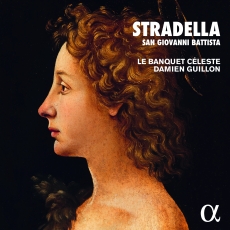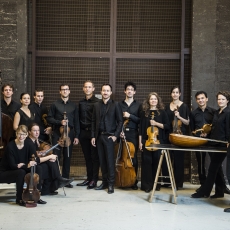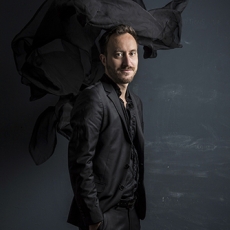Le Banquet Céleste & Damien Guillon - Stradella: San Giovanni - MusicWeb International
Alessandro Stradella was a remarkable composer and his oratorio San Giovanni Battista is a remarkable work. Both have never fallen into oblivion. As far as the composer is concerned, that is mainly due to his adventurous life, which ended with his being murdered as a result of one of his many love affairs. The oratorio was still known in the 19th century, and it was Stradella's first work performed in the 20th century: in 1949 Maria Callas took the role of Eriodiade la figlia, better known as Salome.
San Giovanni Battista was first performed in 1675 in Rome. At that time the genre of the oratorio was relatively new. In the mid-17th century, Giacomo Carissimi wrote and performed many oratorios, mostly based on biblical subjects, and on a libretto in Latin. Most of those oratorios were rather small-scale pieces, often including the role of a narrator (Testo), and only with a basso continuo accompaniment, sometimes with two additional violins. It is telling that some oratorios were called 'motet'; there was no fundamental difference between the two genres. Both could take the nature of a dialogue between two or more characters. How different is Stradella's San Giovanni Battista.
In many ways it shows the features of what was to become the standard in oratorios, and what made it increasingly the secular counterpart of opera. First of all, the libretto Stradella set to music was in Italian. It is the first specimen of what was known as oratorio volgare. This way, the content was easier accessible to audiences who did not know Latin - meaning: people from outside the church. It was the token of the 'secularisation' of the oratorio. Another indication of that is the fact that the first performance did not take place in a church, but in a concert venue. This way, it became a substitute for opera, a genre that was treated with suspicion by the ecclesiastical authorities.
Second, the instrumental ensemble was much larger than was customary in oratorios. In most such works, the singers were accompanied by two violins and basso continuo, sometimes with an additional instrument, such as a trombone, which participated only in one or two arias. Here we have an ensemble of strings, divided into two sections, according to the concerto grosso principle. In one aria, the contrast comes especially to the fore: when Herodes sings 'Tuonerà fra mille turbini', the first part is accompanied by the ripieno, the second by the concertino.
At the time of performance, the dacapo aria had hardly developed yet, and therefore the arias in this oratorio take various forms. There isn't a very strong contrast between recitative and aria yet as well: often the recitatives change into ariosos. Many recitatives are accompanied by the orchestra, which makes Stradella one of the first composers in history to write recitativi accompagnati. That is the third reason this oratorio is a remarkable work.
Most oratorios of the 17th century were performed during Lent, and San Giovanni Battista is no exception: the premiere took place on 31 March. However, the consequence of this was that oratorios usually ended with some kind of reference to Christ's Passion. That is not the case here: the oratorio ends with a duet of Herodes and his daughter, who react in diametrically opposite ways to John the Baptist's execution: "What torture, what torment I sense and feel within me / What joy, what happiness I sense and feel within me". Musically speaking, this is also different from tradition: almost any oratorio ended with a chorus, on a text of a moral nature. In the programme notes to his recording, the German conductor Michael Schneider writes: "A hasty glance at the end of the score could give the impression that some pages had been lost. The last duet in which Salome sings of her joy and Herod of his suffering ends with the question 'e perché?' ("and why?") on a dominant. There is no reconciling ritornello and no concluding tonic to give the impression of a real ending. Numerous even more glaring examples in other works by Stradella leave us in no doubt that this is what was intended".
The many uncommon features and the highly dramatic content explain why San Giovanni Battista is one of the most frequently-performed oratorios of the 17th century. Add to that the quality of the music, and one understands that it is well represented in the catalogue. There is much to enjoy in this new recording. Given that Damien Guillon is an alto, one would probably expect him to perform the part of John the Baptist. However, that role is taken by Paul-Antoine Benos-Djian, a new name to me. He delivers quite an impressive performance. The depth and the intensity of this part comes off very well. His aria 'Io per me non cangerei' is the highlight of this work and is given a magnificent performance. His counterpart, so to speak, is Eriodiade la figlia. Alicia Amo does very well in turning this character from a rather playful into a quite nasty one. Listen to the contrast between the playful aria 'Volin pure lontano dal sen' and the way she tries to convince her father to kill John the Baptist (Deh, che più tardi - Queste lagrime). Amo's voice is perfectly suited for this role. Unfortunately, she now and then uses a bit too much vibrato. Olivier Dejean is completely convincing as Herodes, doing justice to the conflict between his feelings for both John the Baptist and his daughter. The other singers give good accounts of the smaller roles. The ensembles are perfect, despite the different character of the voices. The instrumental ensemble is excellent, and substantially contributes to the dramatic character of this performance.
In short, this is an incisive interpretation of one of the masterpieces of the 17th century. It is not perfect, but certainly one of the best performances available.


